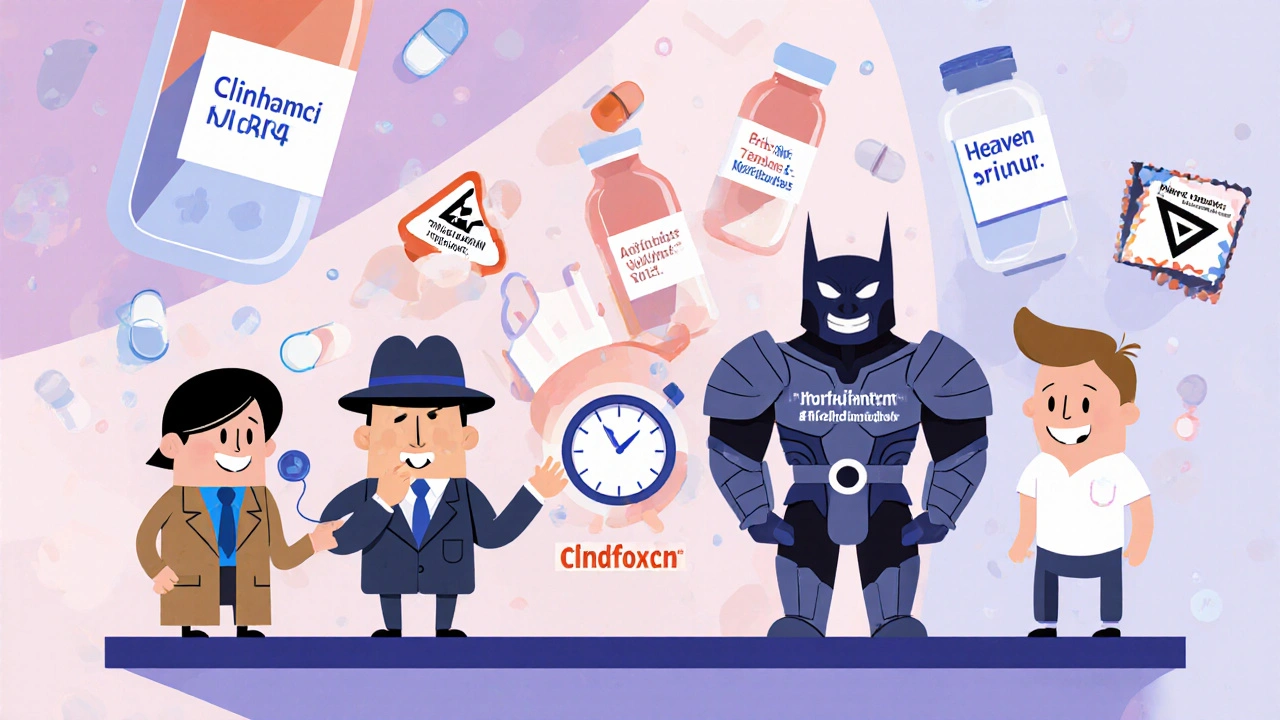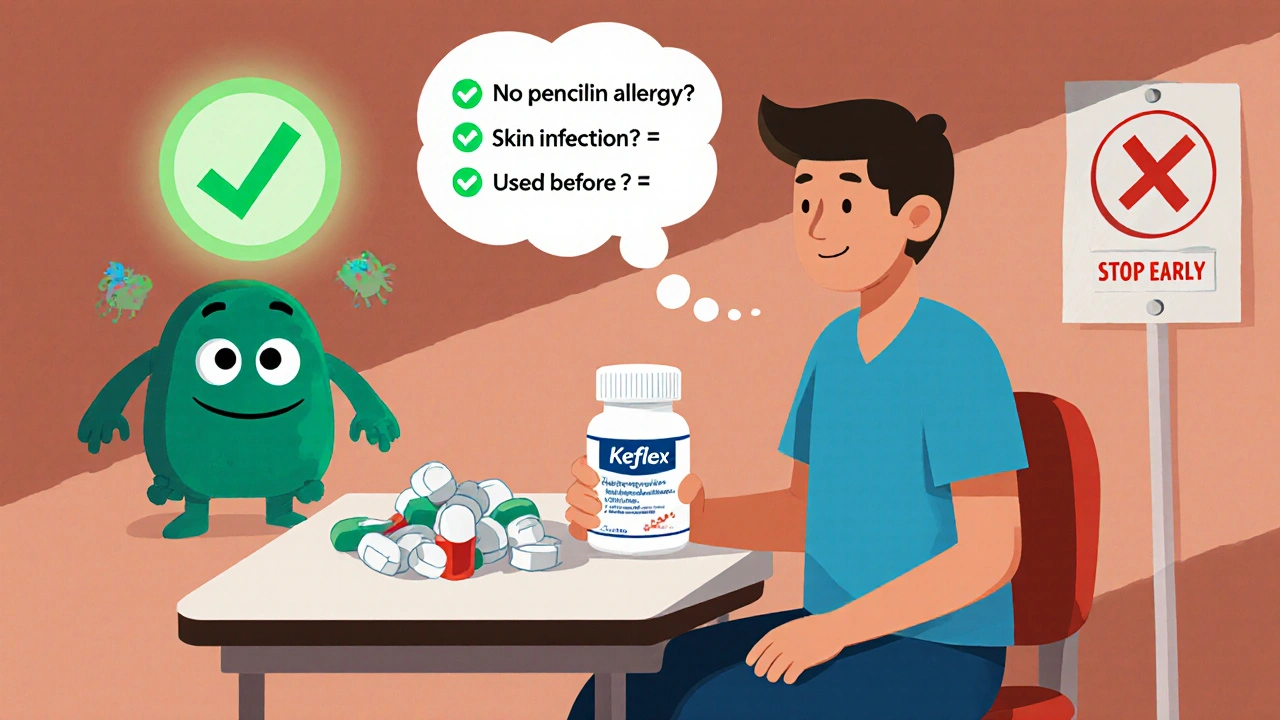Antibiotic Matchmaker: Find Your Best Antibiotic Option
Select Your Infection Type
Select your infection type and medical history to see your recommended antibiotic options.
When you’re prescribed Keflex (cephalexin) for a skin infection, sinus infection, or urinary tract infection, it’s natural to wonder: Is this the best option? Maybe you had a bad reaction. Maybe it didn’t work last time. Or maybe you’re just trying to understand your choices before you even start the pill bottle. The truth is, Keflex isn’t the only antibiotic out there-and it’s not always the right one for every infection.
What is Keflex (Cephalexin)?
Keflex is the brand name for cephalexin, a first-generation cephalosporin antibiotic. It’s been around since the 1960s and is still widely used because it’s cheap, well-tolerated, and effective against many common bacteria. It works by breaking down the cell walls of bacteria, causing them to die.
It’s commonly prescribed for:
- Skin infections like cellulitis and impetigo
- Ear infections (otitis media)
- Respiratory tract infections such as bronchitis or pneumonia (when bacterial)
- Urinary tract infections (UTIs), especially uncomplicated ones
- Bone infections (osteomyelitis) in some cases
Most people take it two to four times a day for 7 to 14 days. Side effects are usually mild-nausea, diarrhea, or stomach upset. But if you’re allergic to penicillin, you might also react to Keflex. About 10% of people with penicillin allergies have cross-reactivity with cephalosporins like cephalexin.
Why Look at Alternatives?
Not every infection responds to Keflex. Some bacteria have become resistant to it over time. Others, like MRSA (methicillin-resistant Staphylococcus aureus), don’t respond at all. And if you’ve had side effects before, you might need something gentler or stronger.
Doctors choose antibiotics based on three things: what kind of infection you have, which bacteria are likely causing it, and your personal health history. That’s why alternatives matter. Here are the most common ones-and when each makes sense.
Amoxicillin: The Penicillin Cousin
Amoxicillin is one of the most prescribed antibiotics in the world. It’s a penicillin-type drug, so if you’re allergic to penicillin, you should avoid it. But if you’re not, it’s often a better first choice than Keflex for many infections.
Here’s how they compare:
| Feature | Amoxicillin | Cephalexin (Keflex) |
|---|---|---|
| Drug Class | Penicillin | Cephalosporin |
| Best For | Ear, sinus, throat, UTI, pneumonia | Skin, bone, some UTIs |
| Dosing Frequency | Two to three times daily | Two to four times daily |
| Penicillin Allergy Risk | Avoid if allergic | May still react (10% risk) |
| Effectiveness Against MRSA | No | No |
| Cost (UK NHS) | £2-£5 for a course | £5-£10 for a course |
Amoxicillin covers a broader range of respiratory bacteria than Keflex. If you have strep throat or a middle ear infection, amoxicillin is usually the first-line choice in the UK. It’s also more effective against certain types of UTIs caused by E. coli.
Clindamycin: For Skin Infections and Penicillin Allergies
If you’re allergic to penicillin and Keflex isn’t safe for you, clindamycin is often the go-to alternative for skin and soft tissue infections. It’s especially useful for MRSA infections, which are becoming more common in the UK.
Clindamycin works differently-it stops bacteria from making proteins they need to survive. It’s taken three to four times a day and can cause serious diarrhea (C. diff infection), so it’s not used unless necessary.
Doctors usually choose clindamycin when:
- You have a skin abscess or boil that’s not improving
- You’re allergic to both penicillin and cephalosporins
- There’s suspicion of MRSA (common in community settings)
It’s not ideal for UTIs or respiratory infections, though. Its spectrum is narrower than Keflex’s for those.

Azithromycin: The Once-Daily Option
Azithromycin (Zithromax) is a macrolide antibiotic. It’s popular because you only need to take it once a day-often for just three to five days. That’s a big advantage for people who struggle with sticking to a strict schedule.
It’s especially useful for:
- Respiratory infections like bronchitis and pneumonia
- Strep throat
- Some sexually transmitted infections (like chlamydia)
But it doesn’t work well for skin infections or UTIs. And while it’s convenient, it’s not always more effective than Keflex. In fact, for skin infections, studies show Keflex clears them faster than azithromycin.
Also, azithromycin can cause heart rhythm changes in people with existing heart conditions. If you’re over 60 or have a history of arrhythmia, your doctor will think twice before prescribing it.
Ciprofloxacin: Stronger, But Not Always Better
Ciprofloxacin is a fluoroquinolone-a powerful antibiotic used for serious infections. It’s often reserved for complicated UTIs, kidney infections, or when other antibiotics fail.
It’s effective against a wide range of bacteria, including those resistant to Keflex. But it comes with serious risks:
- Tendon rupture (especially in older adults or people on steroids)
- Nerve damage (peripheral neuropathy)
- Increased risk of C. diff diarrhea
The UK’s National Institute for Health and Care Excellence (NICE) advises doctors to avoid fluoroquinolones like ciprofloxacin for simple infections like sinusitis or uncomplicated UTIs. They’re overprescribed, and side effects can be long-lasting.
Use ciprofloxacin only if Keflex failed, or if you have a confirmed resistant infection. It’s not a first-line alternative.
Other Options: Doxycycline, Trimethoprim, Nitrofurantoin
For certain infections, other antibiotics are preferred:
- Doxycycline: Good for acne, tick-borne infections (like Lyme), and some respiratory bugs. Not for kids under 12 or pregnant women.
- Trimethoprim: Often used for simple UTIs in the UK. Works as well as Keflex for many cases, with fewer side effects.
- Nitrofurantoin: Only for bladder infections, not kidney or systemic ones. Very safe for most people, but not for those with kidney problems.
These aren’t direct replacements for Keflex across the board-they’re specialists. Your doctor picks based on the infection site and your medical history.

When to Stick With Keflex
Just because there are alternatives doesn’t mean you should avoid Keflex. In many cases, it’s still the best choice.
Stick with Keflex if:
- You have a confirmed skin or bone infection caused by susceptible bacteria
- You’ve taken it before with no side effects
- You don’t have a penicillin allergy
- You need a low-cost, proven option
It’s not outdated. It’s not second-rate. It’s just not universal. The right antibiotic depends on the bug, the body, and the history.
What to Do If Keflex Doesn’t Work
If you’ve finished your Keflex course and your infection is still there-or worse-don’t just start another antibiotic on your own. That’s how resistance grows.
Instead:
- See your GP or nurse. They may take a swab or urine sample to identify the bacteria.
- Ask if a culture test is needed. This tells them exactly which antibiotic will work.
- Discuss your history: allergies, past antibiotics, side effects.
- Don’t pressure them for a “stronger” drug. Sometimes, rest and fluids are all you need.
Antibiotics aren’t magic pills. They’re tools. And using the right one matters-for your health and for everyone else’s.
Common Myths About Antibiotics
There’s a lot of misinformation out there. Here’s what’s true:
- Myth: Antibiotics work for colds and flu. Truth: Viruses cause colds. Antibiotics do nothing.
- Myth: You can stop taking them when you feel better. Truth: Finish the full course-even if you feel fine. Stopping early lets resistant bugs survive.
- Myth: All antibiotics are the same. Truth: Each targets different bacteria. Keflex won’t fix a sinus infection that needs amoxicillin.
- Myth: Natural remedies replace antibiotics. Truth: Honey or garlic won’t cure cellulitis. Delaying real treatment can lead to hospitalization.
Is Keflex better than amoxicillin?
It depends on the infection. Amoxicillin is usually better for ear, sinus, and throat infections. Keflex is better for skin and bone infections. For urinary tract infections, both work, but trimethoprim is often preferred in the UK. There’s no single winner-it’s about matching the drug to the bug.
Can I take Keflex if I’m allergic to penicillin?
Maybe, but not always. About 1 in 10 people with penicillin allergies will also react to Keflex. If you had a serious reaction to penicillin-like swelling, trouble breathing, or anaphylaxis-your doctor will likely avoid Keflex. For mild rashes, they might still prescribe it after careful evaluation.
What’s the safest antibiotic for a UTI?
In the UK, trimethoprim or nitrofurantoin are first-line for simple UTIs. Keflex works too, but it’s not the top choice because of rising resistance. If those don’t work, amoxicillin or cephalexin may be tried next. Always get a urine test if symptoms persist.
Does Keflex cause yeast infections?
Yes. Like most antibiotics, Keflex kills good bacteria along with bad ones. This can let yeast overgrow, especially in the mouth or vagina. If you develop itching, discharge, or white patches, tell your doctor. You might need an antifungal, but don’t stop your antibiotic without talking to them.
How long does Keflex take to work?
Most people start feeling better within 2 to 3 days. But don’t stop taking it then. The infection might still be there. For skin infections, redness and swelling should start to improve within 48 hours. If there’s no change after 3 days, contact your doctor.
Can I drink alcohol while taking Keflex?
Yes, alcohol doesn’t interact with cephalexin. But drinking while sick can make you feel worse-dehydrate you, weaken your immune system, and worsen stomach upset. It’s better to skip it until you’re fully recovered.
Final Thoughts
There’s no single best antibiotic. Keflex is reliable for skin and bone infections, but amoxicillin often beats it for ear and throat bugs. Clindamycin steps in for MRSA. Azithromycin offers convenience. Ciprofloxacin is powerful but risky. The right choice isn’t about what’s newest or strongest-it’s about what matches your infection, your body, and your history.
Always let your doctor guide you. Don’t switch antibiotics based on what a friend took. Don’t save leftover pills for next time. And never pressure your GP for a prescription if they say you don’t need one. Antibiotics save lives-but only when used wisely.


Comments (10)
Jim Allen
October 30, 2025 AT 03:25Bro, I took Keflex for a boil last year and it did absolutely nothing. Then my buddy gave me some clindamycin he had lying around-boom, gone in 48 hours. Don’t get me started on how pharmacies charge $80 for a 7-day course. 🤡
krishna raut
October 30, 2025 AT 22:08Trimethoprim is first-line for UTIs in UK. Keflex okay but resistance rising. Nitrofurantoin safer for bladder. Always test first.
Aditya Singh
October 31, 2025 AT 02:59Let’s be real-cephalexin is a 1960s relic. You’re using a rotary phone while everyone else has 5G. Amoxicillin has broader gram-negative coverage, clindamycin handles MRSA, and fluoroquinolones? They’re not ‘stronger,’ they’re last-resort nuclear options. Your GP’s prescribing Keflex because it’s cheap, not because it’s optimal. This isn’t medicine-it’s pharmaceutical inertia.
Katherine Reinarz
November 1, 2025 AT 00:48OMG I got a yeast infection from Keflex and my boyfriend left me bc I was ‘too gross’ 😭😭😭 now I’m on nystatin and crying into my chamomile tea
Callum Breden
November 2, 2025 AT 13:13This article is dangerously oversimplified. The assertion that ‘Keflex is still effective’ ignores regional resistance patterns. In urban US clinics, >40% of S. aureus isolates are MRSA. Prescribing cephalexin without culture data is not just negligent-it’s a public health liability. Furthermore, the cost comparison ignores hidden expenses: ER visits due to treatment failure, prolonged sick leave, and downstream Clostridioides difficile infections. This is not medical advice-it’s a brochure.
Nate Girard
November 3, 2025 AT 00:57Just wanted to say thank you for this breakdown. I’ve been scared to ask my doctor about alternatives because I didn’t want to seem ‘difficult.’ But now I feel empowered to say, ‘Can we test for the bacteria first?’ I had a UTI last month and they just gave me Keflex-I felt awful for days. Next time I’m asking about trimethoprim. 💪
phenter mine
November 4, 2025 AT 20:49i took azithromycin for my bronchitis and it was soo much easier cause i just did 1 pill a day for 3 days. i forgot to take it once and i was like ‘eh its fine’ but then i felt worse so i finished it. dont be like me lol
John Kane
November 5, 2025 AT 06:31Hey everyone, I’m a retired ER nurse and I’ve seen too many people treat antibiotics like candy. I get it-you’re tired, you want to feel better yesterday. But here’s the thing: every time you take an antibiotic you don’t need, or stop early, or share someone else’s prescription, you’re helping superbugs win. I’ve had patients come in with infections that no drug touches because they took cipro for a cold in 2015. Keflex isn’t perfect, but it’s not the enemy. The enemy is ignorance. Talk to your doctor. Get tested. Don’t Google your diagnosis. Your body isn’t a TikTok trend.
Mansi Gupta
November 6, 2025 AT 05:55Thank you for the clear comparison. In India, we often face antibiotic overuse due to pharmacy dispensing without prescription. It is reassuring to see guidelines emphasizing culture tests and appropriate selection. Nitrofurantoin remains a safe and effective option for uncomplicated cystitis, and trimethoprim is widely used with good outcomes when resistance is low. Awareness is the first step toward responsible use.
Carolyn Kiger
November 8, 2025 AT 03:13My grandma in Ohio used to say, ‘If it ain’t broke, don’t fix it.’ She took Keflex for every infection for 30 years and never had a problem. She didn’t need MRSA coverage or fancy culture tests-she had a good doctor who listened. Maybe the real issue isn’t the antibiotic… it’s that we’ve forgotten how to trust the people who’ve been doing this longer than we’ve been alive.